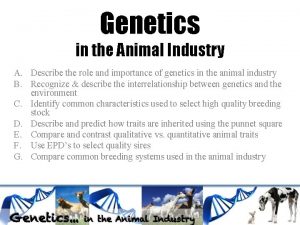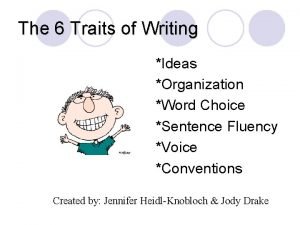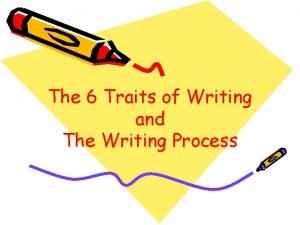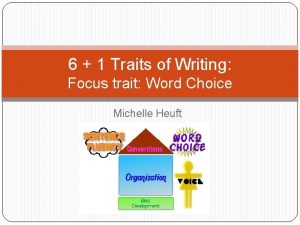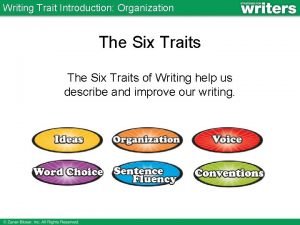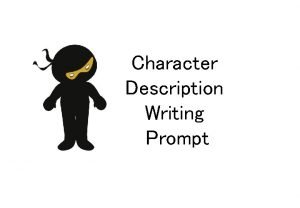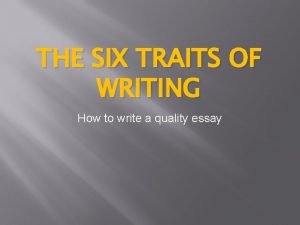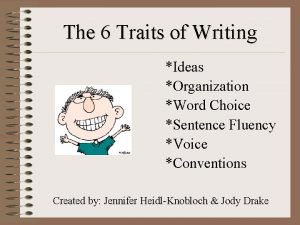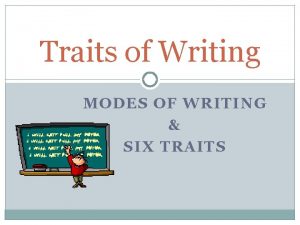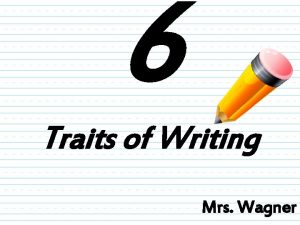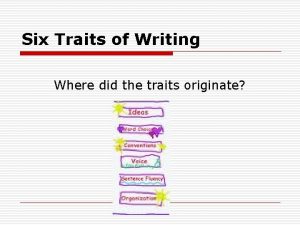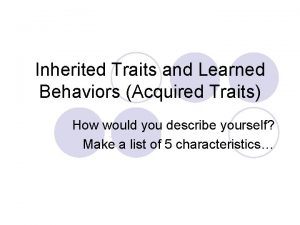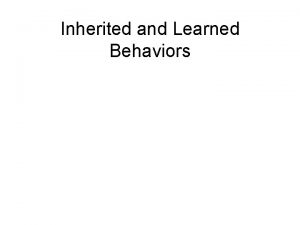The 6 Traits of Writing and The Writing





























- Slides: 29

The 6 Traits of Writing and The Writing Process

What are The 6 Traits of Writing? • The traits are not new. • A trait can be defined as a quality or characteristic critical to successful performance. • Just as there are traits for good ice skating, tennis, etc. , there are traits for good writing.

The Traits of Good Writing • The traits for good writing include: ideas, organization, voice, word choice, sentence fluency, and conventions. • Traits give the writer a clear picture of what to do make their writing the best it can be.

Writing Process Step 1 = Prewrite Step 2 = Draft Step 3 = Share Step 4 = Revise / Edit Step 5 = Publish

Purpose • To give teachers and students the same language and expectations of writing. • Teachers want students to transfer their writing skills into all their classes, not just within their language arts experience.

The Writing Prompt • You will receive a writing prompt – FORM, TOPIC, AUDIENCE, and PURPOSE (F-TAP). • You must generate IDEAS to address the TOPIC and DEVELOP the ideas so they can address the PURPOSE of the piece of writing. • CLARITY and FOCUS are key

Ideas • A paper with good ideas is clear, focused, and holds the reader’s attention. • Ideas are the heart of the message; they are the reason we are writing.

To Encourage Good Ideas: • Ask yourself: -Is my message clear? -Do I know enough about my topic? -Is it interesting? -Is my topic “small” and focused? -Did I show what was happening?

How the Trait is Related to the Writing Process IDEAS You write down ideas and focus your topic in the PREWRITING stage of the Writing Process.

Organization • Organization is the internal structure of the piece of writing – The thread of central meaning, – The logical and sometimes intriguing pattern of the ideas.

Why Organization? • Organization gives direction to all writing by drawing the reader in. – Enhances and showcases the central theme or storyline. – Everything fits together like a puzzle – Leaves the reader with something to think about.

To Encourage Organization: • Ask yourself: -Does my paper have a good opening that captures the reader’s attention? -Are my ideas in the best order? -Does my paper have a strong ending?

How the Trait is Related to the Writing Process Organization You develop your focused idea into a well structured writing during the DRAFTING stage of the Writing Process. Make sure you have beginning, middle, and end. Don’t forget to use transitions.

Voice • The voice is the heart and soul, the magic, the wit, along with the feeling and conviction of the individual writer coming out through the words. • Voice gives writing personality, flavor and style. • In a paper with strong voice, the writer speaks directly to the reader and is sensitive to the reader’s needs.

To Encourage Voice • Ask yourself: -Does this writing sound like me? -Did I say what I think and feel? -Does my writing have energy and passion? -Is it appropriate for my audience and purpose?

How the Trait is Related to the Writing Process Voice You develop the voice of a writer when you SHARE your writing with a peer.

Word Choice • Word choice is the use of rich, colorful, precise language that moves and enlightens the reader.

Word Choice • Word Choice enriches our writing and makes it almost come alive. • Precise words add energy and clarity. • Words convey the intended message in a clear, interesting and natural way.

To Encourage Word Choice: • Ask yourself: -Will my reader understand my words? -Were my words accurate, original, and just right? -Did I use energetic verbs? -Did I use language that painted a picture?

How the Trait is Related to the Writing Process Word Choice During the REVISION stage you make sure your Word Choice is appropriate for the audience and topic.

Sentence Fluency • Sentence fluency is the rhythm and flow of the language, the sound of word patterns, the way in which writing plays to the ear—not just to the eye.

Sentence Fluency • Sentences are well built with strong and varied structures. Sentences are clear and powerful. As our writing skills grow, we learn new ways to “sculpt” our writing.

To Encourage Sentence Fluency: • Ask yourself: -How does my writing sound when read aloud? -Do my sentences begin in different ways? -Are some sentences long and some short?

How the Trait is Related to the Writing Process Sentence Fluency During the REVISION stage you examine your writing for variety in sentence length and structure.

Conventions • Conventions are the mechanical correctness of the piece—spelling, grammar and usage, paragraphing, use of capitals and punctuation.

To Encourage Conventions: • Ask yourself: -Did I paragraph correctly? -Is my spelling correct? -Did I correctly use periods, question marks, commas, quotation marks, etc. ? -Did I use capital letters correctly?

How the Trait is Related to the Writing Process Conventions This trait is the “cleaning crew” of the writing piece. This takes place during the EDITING stage. Here you check for errors in spelling, punctuation, and grammar usage.

The +1 Trait Presentation takes place in the final stage of the Writing Process – PUBLISH. Presentation deals with how the writing looks on the page.

The 6 Traits of Writing ideas Organization Voice word choice sentence fluency conventions
 Inheritance of quantitative traits
Inheritance of quantitative traits Qualitative traits vs quantitative traits
Qualitative traits vs quantitative traits Qualitative traits vs quantitative traits
Qualitative traits vs quantitative traits 6 plus 1 traits of writing
6 plus 1 traits of writing 6 traits of writing ideas
6 traits of writing ideas 6 traits of effective writing
6 traits of effective writing 6 traits of writing graphic organizer
6 traits of writing graphic organizer Six traits of a good character
Six traits of a good character Character description prompt
Character description prompt 6 traits of writing organization activities
6 traits of writing organization activities Six traits of effective writing
Six traits of effective writing Begining transition words
Begining transition words Hình ảnh bộ gõ cơ thể búng tay
Hình ảnh bộ gõ cơ thể búng tay Slidetodoc
Slidetodoc Bổ thể
Bổ thể Tỉ lệ cơ thể trẻ em
Tỉ lệ cơ thể trẻ em Voi kéo gỗ như thế nào
Voi kéo gỗ như thế nào Chụp phim tư thế worms-breton
Chụp phim tư thế worms-breton Alleluia hat len nguoi oi
Alleluia hat len nguoi oi Môn thể thao bắt đầu bằng chữ f
Môn thể thao bắt đầu bằng chữ f Thế nào là hệ số cao nhất
Thế nào là hệ số cao nhất Các châu lục và đại dương trên thế giới
Các châu lục và đại dương trên thế giới Công thức tiính động năng
Công thức tiính động năng Trời xanh đây là của chúng ta thể thơ
Trời xanh đây là của chúng ta thể thơ Cách giải mật thư tọa độ
Cách giải mật thư tọa độ 101012 bằng
101012 bằng Phản ứng thế ankan
Phản ứng thế ankan Các châu lục và đại dương trên thế giới
Các châu lục và đại dương trên thế giới Thể thơ truyền thống
Thể thơ truyền thống Quá trình desamine hóa có thể tạo ra
Quá trình desamine hóa có thể tạo ra


